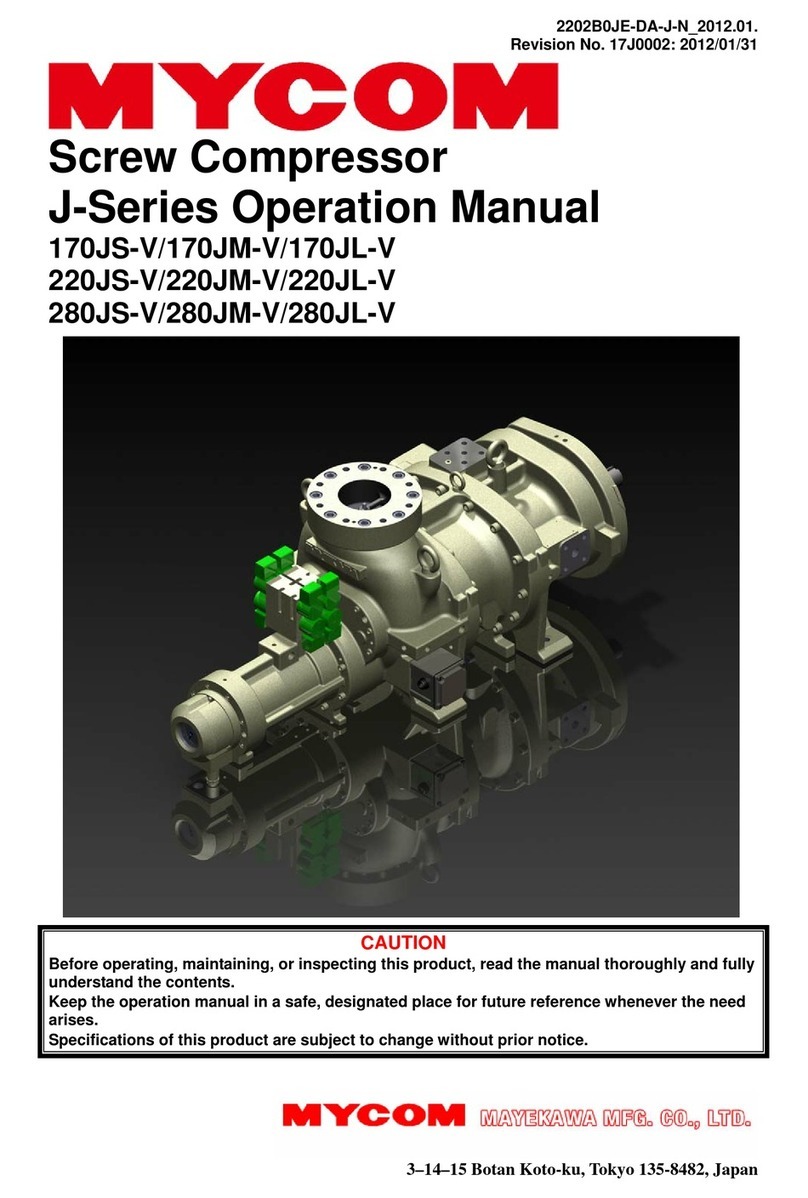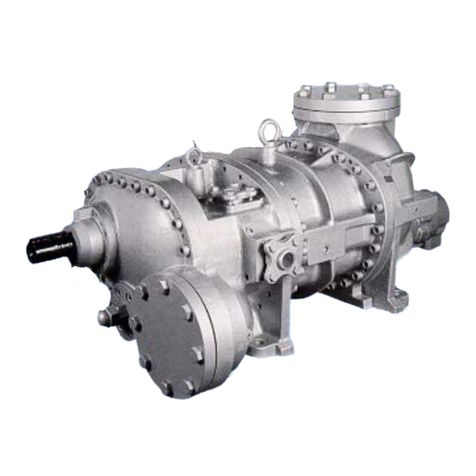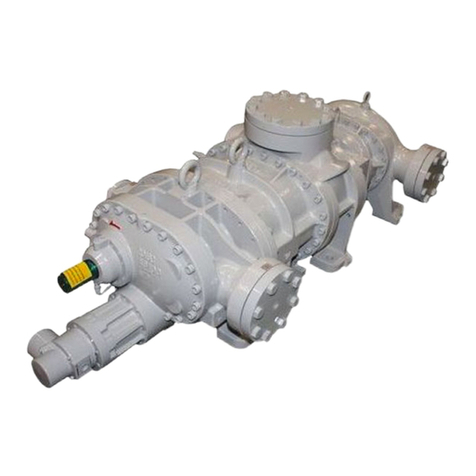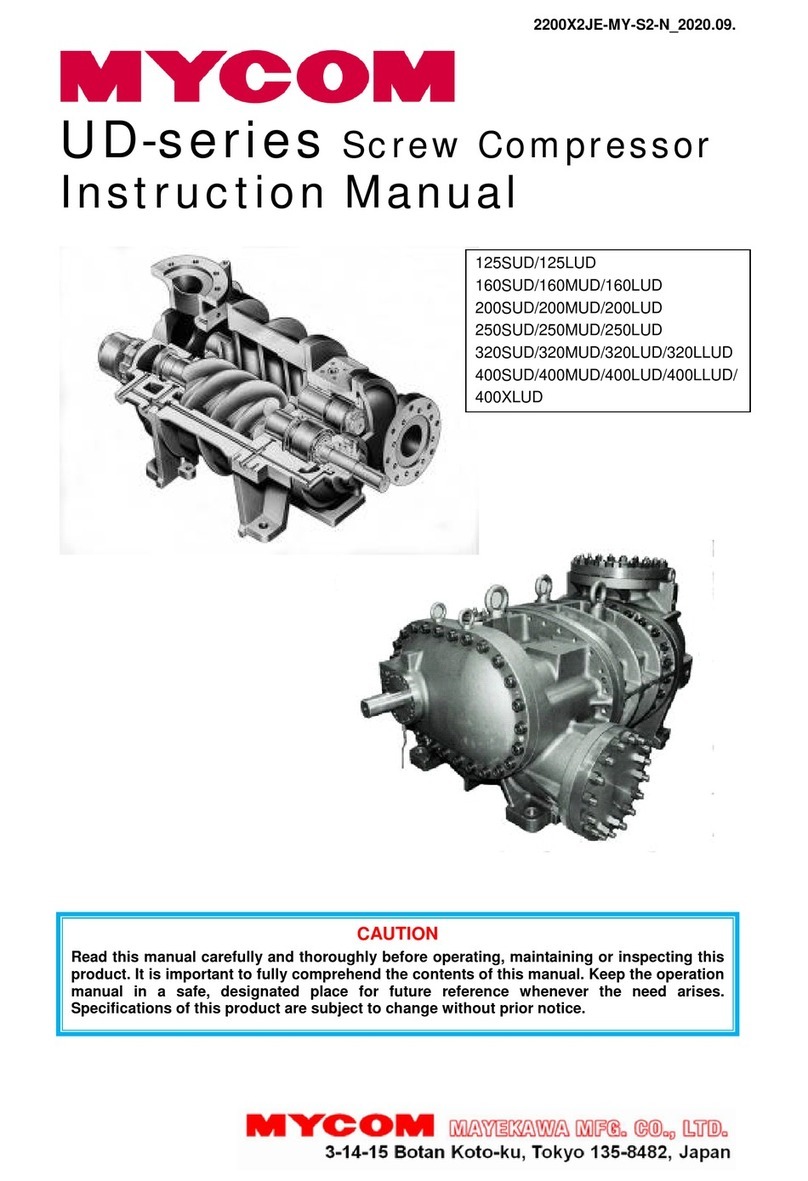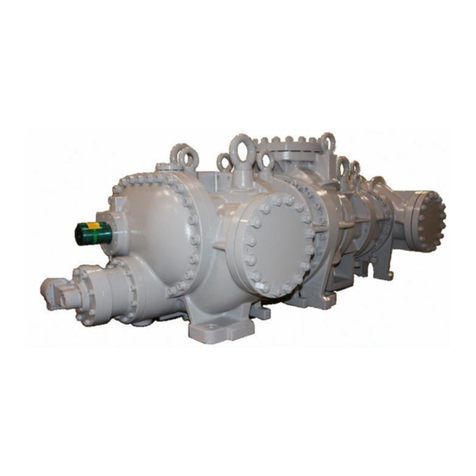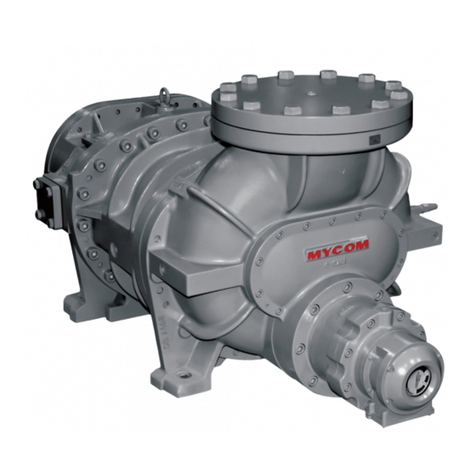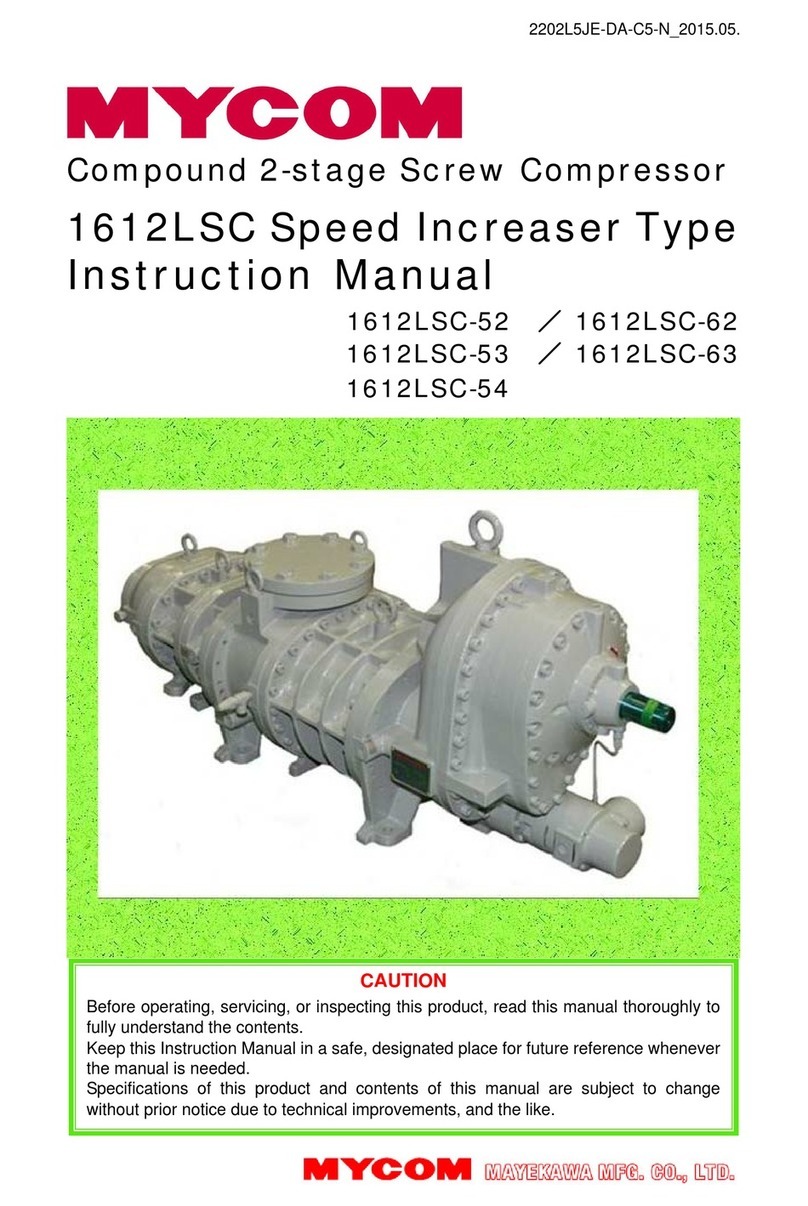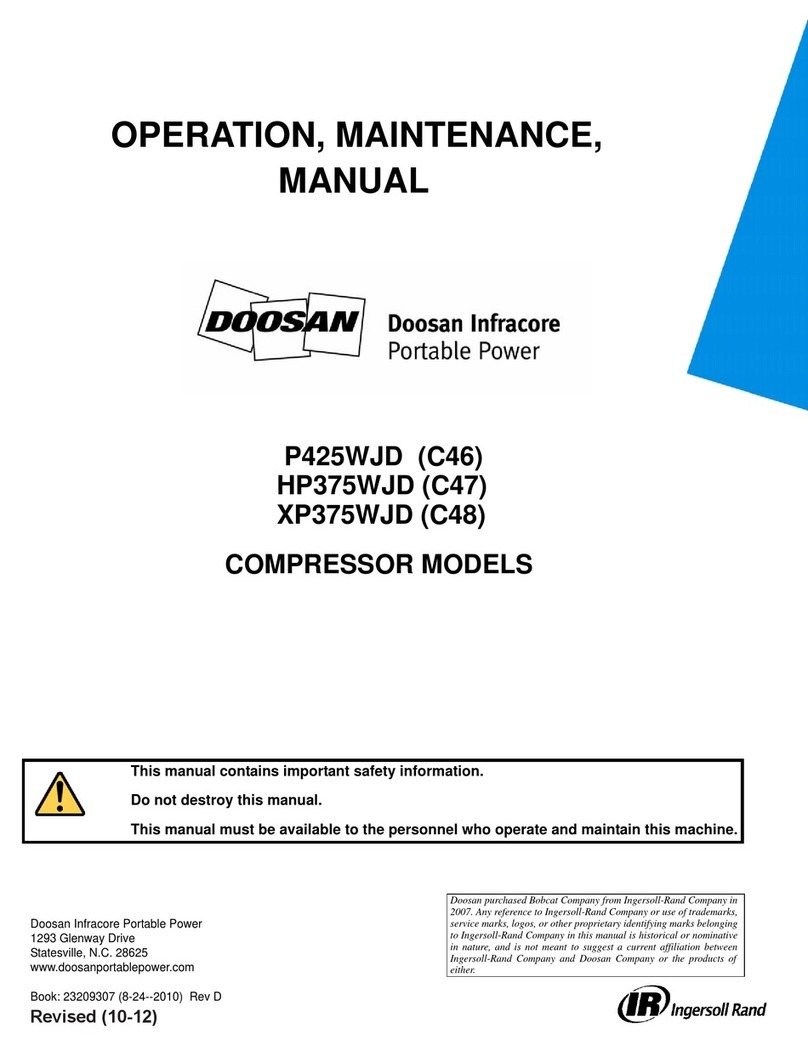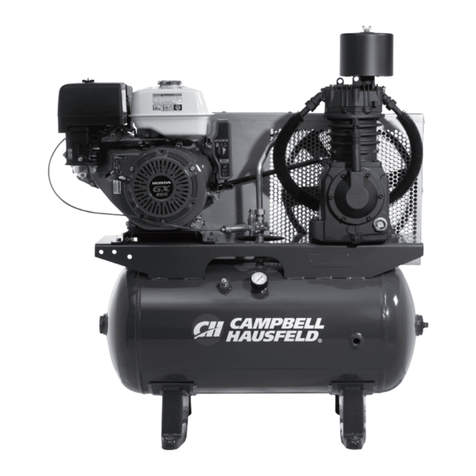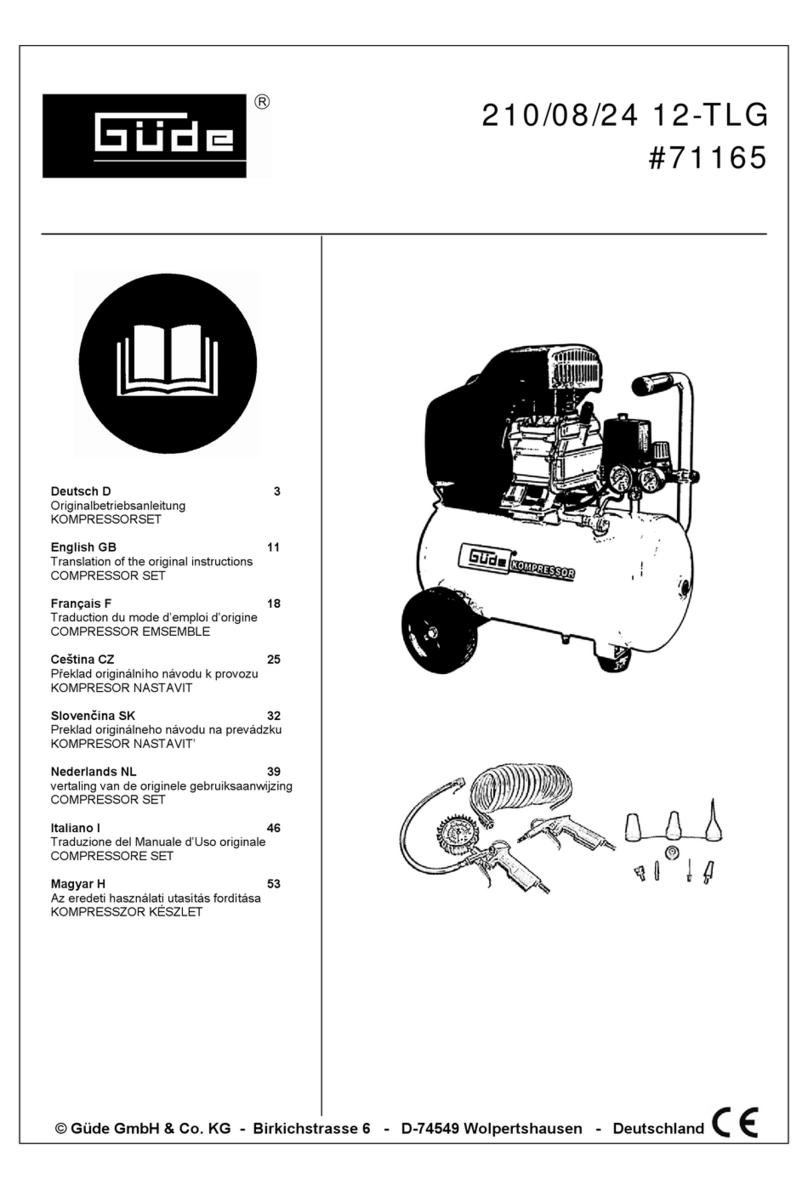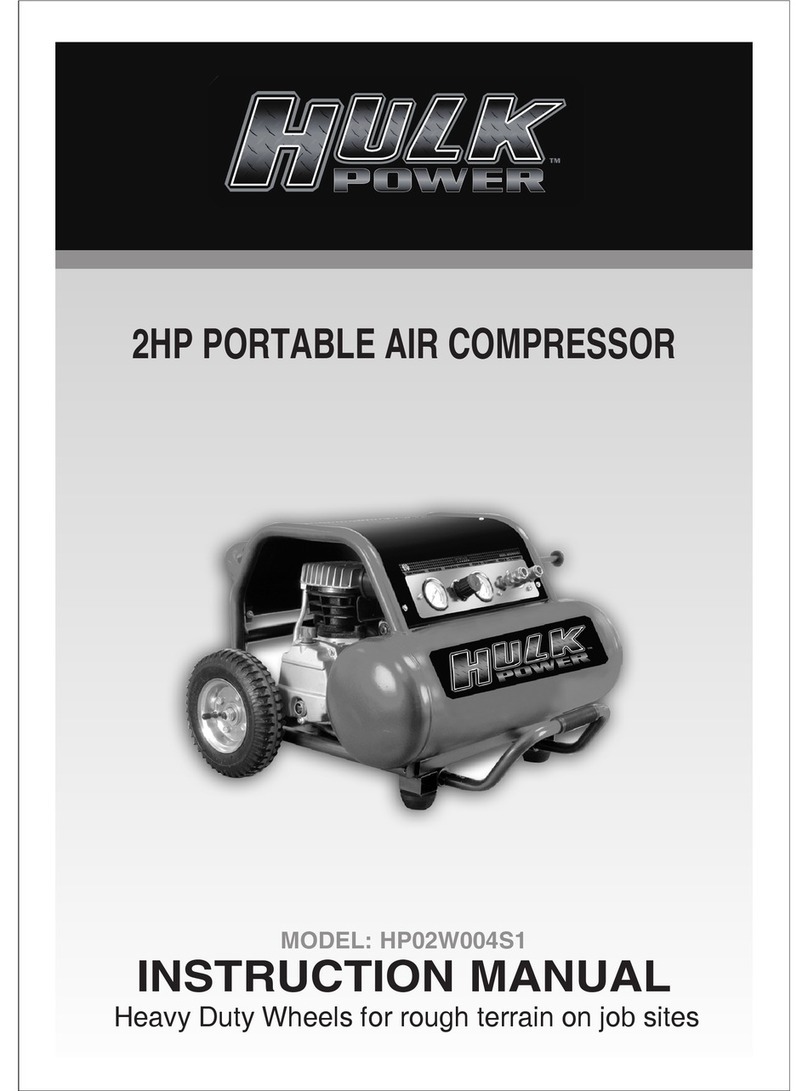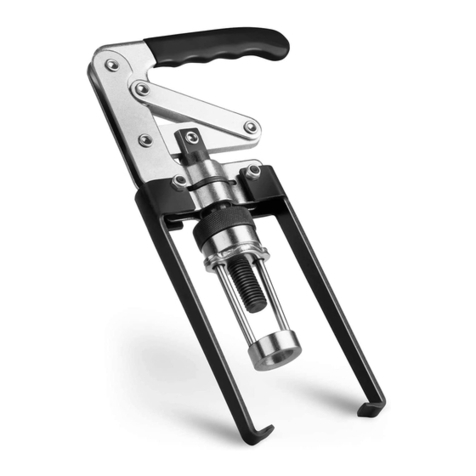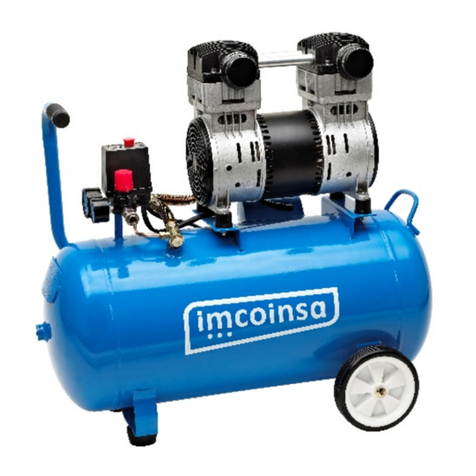mycom i125S User manual

2203M4JE-MY-iS2-N_2017.04.
i-Series Screw Compressor
Instruction Manual i125S / i125L
i160S / i160M / i160L
CAUTION
Before operating, servicing, or inspecting this product, read this manual thoroughly to
fully understand the contents.
Keep this instruction manual in a safe, designated place for future reference whenever
the manual is needed.
Specifications of this product and contents of this manual are subject to change without
prior notice due to technical improvements, and the like.
This manual is applied to each compressor after the serial number
shown below.
i125S: 8750303 i125L: 8770301
i160S: 8710055 i160M: 8720018 i160L: 8730030

2203M4JE-MY-iS2-N_2017.04.
Preface
Screw Compressor i-series i
Preface
Thank you for purchasing our i-series screw compressor (hereinafter referred to as "this
product").
This instruction manual (hereinafter referred to as "this manual") provides safety information and
operation and maintenance procedures, so that users correctly understand how to handle this product
and, as a result, can use it safely and efficiently.
Before installing or using this product, make sure you read this manual.
Keep this manual in a safe place near this product for quick reference.
Revision History
Title Document No. First edition issue date
i-Series Screw Compressor
Instruction manual 2203M4JE-MY-iS2-N_2017.04. April 28, 2014
Revision
No. Issue Date Major contents of revisions Created
/ approved by:
00 April 28, 2014 Newly is
sued as applicable to the product after May
2014, due to modification of the i-series specifications. Muta
/ Ikeda, Hirao
01 Sep. 24, 2014 Added models for IEC motor flange specifications.
Amanuma, Kato /
Ikeda, Hirao
02
June 01, 2015
Modified the constitution of Chapter 4 and Chapter 5.
Added the basic multi-packaging points using plural
i-sereis compressors.
Kitahara,
Fujimoto / Ikeda
03
April 30, 2017
Corrected 2.3.1 Standard Specifications, 2.4.3 Parts
Configuration Table . Deleted Contact Information.
Takenouchi,
Ito / Kato

2203M4JE-MY-iS2-N_2017.04.
Warranty and Disclaimer
Screw Compressor i-series ii
Warranty and Disclaimer
Warranty Clauses
MAYEKAWA shall repair or replace parts of this product for no charge if any failure resulting from
defects in design or manufacture occurs, under normal use with the purpose and method that are in
accordance with the specifications of this product and this manual, within the warranty period.
The warranty period is "12 months from factory shipment of this product". If there is a separate
agreement, that agreement shall prevail in principle.
MAYEKAWA is not liable for production or man-made disaster compensation due to malfunction or
damage of this product.
Disclaimer of Warranty
Although MAYEKAWA warrants the clauses mentioned above, the following clauses are exempted.
Malfunction or damage of this product caused by natural disaster, or other accidental forces
(such as fire, thunderbolt, windstorm, intense rainfall, flood, tidal wave, earthquake, land
subsidence, etc.).
Malfunction or damage caused by misusage described below.
•Malfunctions, damage, or deterioration of this product due to abnormal or improper use
(including improperly storing this product outdoors or under too hot/humid conditions,
unexpected inspections, tests, operations, too frequent liquid flow-back operation*, and
too frequent start-stop cycles, etc.).
•Malfunction or damage caused by devices or equipments not provided by MAYEKAWA
including operation control methods of those devices.
•Malfunction or damage caused by refrigerants, gases, or refrigerant oils, and operating
conditions (design conditions) not approved for this product.
•Malfunction or damage caused by maintenance or inspection not recommended by
MAYEKAWA.
•Malfunction or damage caused by parts that are not genuine.
•Malfunction or damage caused by remodeling the product without approval of
MAYEKAWA.
•Malfunction or damage caused by unexpected misusage
"Liquid flow-back operation" is ・・・
Normally, while the compressor sucks in the refrigerant liquid only after vaporizing it in the
evaporator, it may directly sucks it in because of the faulty adjustment or failure of the
expansion valve. We call this state of compressor operation "liquid flow-back operation".
No compressor can compress a liquid. The compressor may be damaged should the liquid be
sucked in.

2203M4JE-MY-iS2-N_2017.04.
Important Information
Screw Compressor i-series iii
Important Information
Intended Use of this Product
This product is a general-purpose screw compressor for refrigeration and cold storage. Do not use this
product for any other purposes that are not intended for or which depart from the specifications. For
specifications of this product, refer to "2.3 Compressor Specifications".
Please perform the maintenance items described in this manual by using safe and assured procedures.
Important Information for Safe Use of this Product
Although MAYEKAWA has paid a lot of attention to safety measures for this product, all hazards
including potential hazards caused by human errors, or due to environmental conditions can not be
anticipated.
As there are too many items to be strictly observed or prohibited when using this product, it is
impossible to inform all of them through this manual or warning labels. Therefore, when operating this
product, pay extreme caution on personnel safety as well as on items described in this manual.
Important rules for safety work with this product that apply to all workers including managers and
supervisors are listed below.
Please read this manual before using this product. Fully understand the instructions provided there,
and be sure to perform the safety procedures described in this manual.
Operation, maintenance, and inspection of this product should be performed by qualified
personnel educated about the fundamentals of this product and trained about hazards
involved and measures to avoid danger.
Do not allow any person other than those educated on the fundamental expertise of this
product and trained about hazards involved and measures to avoid dangers to approach this
product while it is operating or during maintenance.
Observe all related federal/national and local codes and regulations.
To prevent accidents, do not carry out any operation or maintenance other than those
described in this manual. Do not use this product for any purpose other than intended.
Replace the parts with the genuine parts.
Not only workers but also managers should actively participate safety and health activities in
the workplace to prevent accidents.
When closing or opening a valve during work, make sure to apply lockout/tagout to prevent
the valve from being accidentally closed or opened during the work.
[Lockout] To lock with a key in order to keep people, except the workers involved, from
operating the product.
“Lockout” means disconnecting or keeping disconnected machines and devices by locking their
energy (power) sources. Lockout is not just simply turning off the power switches to stop the
supply of power, but includes immobilizing them with a key or similar device to keep any blocked
switches from being operated.
Lockout devices are devices such as keys, covers, and latches, to immobilize switches, valves,
opening and closing levers, etc., with a state of being locked.

2203M4JE-MY-iS2-N_2017.04.
Important Information
Screw Compressor i-series iv
[Tagout] To prevent any inappropriate work by hanging tag plates indicating "work in
progress".
“Tagout” means to clearly indicate, by hanging tag plates, that a device is in lockout and that
operation of the device is prohibited. Tag plates forbidding operation, starting, opening, etc. are
warnings clearly stating to not operate energy (power) sources, and are not for stopping blocking
devices.
Observe the following precautions when performing maintenance work on electrical control.
Electrical maintenance of the product must be performed by certified/qualified personnel and
only those educated about the electrical control of the product.
Before servicing or inspecting the electrical equipment or devices, turn "OFF" the motor main
power and control power, and perform lockout/tagout to prevent the power from being turned
on during work.
Even when the motor main power and control power are turned "OFF", this product may be turned on if
the power is supplied from outside the package unit in which this product is used. Make sure the power
supply on the power source side is shut off, and perform lockout/tagout to prevent the product from
being turned on during work.
About This Manual
This product may be modified without prior notice. Therefore, the appearance of actual
machine may differ from the descriptions in this manual. If you have any questions, contact
our sales offices or service centers. For each sight of MAYEKAWA, refer to following URL.
http://www.mayekawa.com/about/network/
This manual is in English. If any other language is required, it is the customers’responsibility
to prepare a manual for safety education and operation instructions.
This manual is copyrighted. Drawings and technical references including this manual shall not,
in whole or part, be copied, photocopied, or reproduced into any electronic medium or
machine-readable form without prior permission from MAYEKAWA.
Photographs or drawings included in this manual may differ from the appearance of actual
product.
If this manual is lost or damaged, immediately request to one of our local sales offices or
service centers for a new manual. Using this product without the manual may result in safety
issues.
When you resell this product, be sure to transfer this manual to the next owner.

2203M4JE-MY-iS2-N_2017.04.
Important Information
Screw Compressor i-series v
Structure of This Manual
Chapter/Section Title Description
Preface Describes the outline of this manual and how to read this manual.
Warranty and Disclaimer Describes what MAYEKAWA warrants and what
are covered by the
warranties.
Warranty exemption is stated as disclaimer.
Important Information Describes important information related to this product and this manual.
1. Safety Describes safety information for the worker, safety rules for this product,
and management details regarding the work safety that is required for
handling this product.
2. Compressor
Specifications and
Configuration
Describes the main components of this product, functional
information,
specification, operating limits, drawings, and parts list.
3. Installation Describes the installation procedure of this product.
4. Compressor and Package
Unit Operation
Describes the precautions for operating this product
and the package
unit..
5. Maintenance and
Inspection
Describes sections and period for inspecting, and assembly and
disassembly of this product.
6. Troubleshooting Describes troubl
eshooting methods for this product in case problems
occur during operation of this product.
7. Related Documents List of disassembly tools for i-series compressor, and other information
Appendix 1 :
Packaging Points 1 Describes basic points for the design and manufacture of a i-
series
compressor package unit.
Appendix 2:
Packaging Points 2 Describes basic multi-packaging points using plural i-sereis
compressors.

2203M4JE-MY-iS2-N_2017.04.
Table of Contents
Screw Compressor i-series vi
Table of Contents
Preface ..................................................................................................................
ⅰ
Revision History...................................................................................................
ⅰ
Warranty and Disclaimer......................................................................................
ⅱ
Important Information ..........................................................................................
ⅲ
Intended Use of This Product ...........................................................................................ⅲ
Important Information for Safe Use of This Product ..........................................................ⅲ
About This Manual.............................................................................................................ⅳ
Structure of This Manual....................................................................................................ⅴ
Table of Contents.................................................................................................
ⅵ
1 Safety
1.1 Strict Requirements and Prohibitions.......................................................1-1
1.1.1 Strict Requirements (Do's)................................................................................... 1-1
1.1.1.1 Do's on Operation........................................................................................ 1-1
1.1.1.2 Do's on Maintenance................................................................................... 1-1
1.1.1.3 Do's on Lockout/Tagout after Shutting Off the Power ................................. 1-2
1.1.1.4 Do's about Personal Protective Gear.......................................................... 1-2
1.1.1.5 Do's about the Handling of Hazardous and Toxic Substances.................... 1-2
1.1.1.6 Do's about Handling Emergency Situations................................................ 1-2
1.1.1.7 Do's about Waste Oil, Fluid, and Materials ................................................. 1-2
1.1.1.8 Other Do's.................................................................................................... 1-2
1.1.2 Prohibitions (Don'ts) ............................................................................................ 1-3
1.2 Warnings.....................................................................................................1-3
1.3 Residual Risks............................................................................................1-4
1.4 Safety Devices............................................................................................1-6
1.4.1 Emergency Stop Button....................................................................................... 1-6
1.4.2 Circuit Breakers of Motor Main Power and Control Power
(with Lockout/Tagout Mechanism)....................................................................... 1-6
1.4.3 Compressor Protective Devices................................................................1-7
Chapter 2 Compressor Specifications and Configuration
2.1 Features of
i-Series Compressor ........................................2-1
2.2 Model Designation of the Compressor.....................................................2-1
2.3 Compressor Specifications .......................................................................2-2
2.3.1 Standard Specifications....................................................................................... 2-2
2.3.2 Operation limits.................................................................................................... 2-3

2203M4JE-MY-iS2-N_2017.04.
Table of Contents
Screw Compressor i-series vii
2.3.3 Alarm Set Values................................................................................................. 2-4
2.3.4 Outer Dimensions................................................................................................ 2-5
2.4 Configuration of Compressor..................................................................2-18
2.4.1 Sectional Views ................................................................................................. 2-18
2.4.2 Exploded Views ................................................................................................. 2-24
2.4.3 Parts Configuration Table.................................................................................. 2-26
2.5 Mechanisms..............................................................................................2-33
2.5.1 Basics of the Screw Compressor ...................................................................... 2-33
2.5.2 Suction Process................................................................................................. 2-33
2.5.3 Compression Process........................................................................................ 2-34
2.5.4 Discharge Process............................................................................................. 2-34
2.5.5 About Volume Ratio (Vi).................................................................................... 2-34
2.5.6 Capacity Control Mechanism............................................................................. 2-36
Chapter 3 Installation
3.1 General Precautions for Installation .........................................................3-1
3.2 Installation Works.......................................................................................3-1
3.2.1 Unpacking............................................................................................................ 3-1
3.2.2 Storage ................................................................................................................ 3-1
3.2.3 Transportation...................................................................................................... 3-1
3.2.4 Preparation for Installation................................................................................... 3-3
3.2.5 Installation............................................................................................................ 3-3
3.2.5.1 Piping Connection ....................................................................................... 3-3
3.2.5.2 Equipment and Devices for Protection of the Compressor......................... 3-4
3.2.6 Airtightness Test.................................................................................................. 3-4
3.2.7 Lubricating Oil Charge......................................................................................... 3-4
3.2.7.1 Initial Charge of Lubricating OIL.................................................................. 3-5
3.2.7.2 Additional Charge of Lubricating Oil............................................................ 3-5
3.2.8 Charge of Refrigerant.......................................................................................... 3-5
3.2.9 Check after Installation........................................................................................ 3-5
Chapter 4 Compressor and Package Unit Operation
4.1 Lubricating Oil (Refrigerant Oil) ................................................................4-1
4.1.1 Precautions for Selecting the Lubricating Oil....................................................... 4-1
4.1.2 Recommended Lubricating Oils .......................................................................... 4-2
4.1.2.1 Recommended Lubricating Oils for Ammonia Refrigerant.......................... 4-2
4.1.2.2 Oils for Systems Using Hydrofluorocarbon (HFC) Refrigerants.................. 4-3
4.1.3 Change of Lubricating Oil Brand ......................................................................... 4-3
4.1.4 Precautions for Handling Lubricating Oil............................................................. 4-4
4.1.5 Lubricating Oil Management Criteria................................................................... 4-4
4.1.6 Lubricating Oil Replacement Timing.................................................................... 4-5

2203M4JE-MY-iS2-N_2017.04.
Table of Contents
Screw Compressor i-series viii
4.1.6.1 After Starting the Initial Operation .............................................................. 4-5
4.1.6.2 During Normal Operation ........................................................................... 4-5
4.2 Precautions for Operation .........................................................................4-6
4.2.1 Prevention of Liquid Flow-back ........................................................................... 4-6
4.2.2 Purging of Non-Condensable Gases................................................................... 4-6
4.3 When Stopping the Compressor for a Long Time....................................4-7
Chapter 5 Maintenance and Inspection
5.1 Precautions for Maintenance and Inspection...........................................5-1
5.2 Maintenance and Inspection List ..............................................................5-3
5.2.1 Daily Management............................................................................................... 5-3
5.2.2 Periodic Inspection .............................................................................................. 5-5
5.2.3 Guidelines for Compressor Overhaul Interval ..................................................... 5-6
5.3 Compressor Disassembly Preparation.....................................................5-7
5.3.1 Disassembly Tools and Work Place.................................................................... 5-7
5.3.2 Replacement Parts.............................................................................................. 5-8
5.3.3 Refrigerant Gas Treatment................................................................................ 5-10
5.3.3.1 Valves Used............................................................................................... 5-10
5.3.3.2 Refrigerant Gas Recovery......................................................................... 5-10
5.3.4 Removing Parts Connected to the Unit............................................................. 5-11
5.3.5 Removing and Lifting the Compressor.............................................................. 5-11
5.3.6 Removing Oil from Compressor........................................................................ 5-11
5.4 Disassembly and Inspection ...................................................................5-12
5.4.1 Shaft Seal Block ................................................................................................ 5-12
5.4.1.1 Disassembly.............................................................................................. 5-12
5.4.1.2 Inspection .................................................................................................. 5-13
5.4.2 Bearing Cover.................................................................................................... 5-14
5.4.2.1 Disassembly .............................................................................................. 5-14
5.4.2.2 Inspection................................................................................................... 5-14
5.4.3 Balance Piston................................................................................................... 5-15
5.4.3.1 Disassembly .............................................................................................. 5-15
5.4.3.2 Inspection .................................................................................................. 5-15
5.4.4 End Cover.......................................................................................................... 5-15
5.4.5 Thrust Bearing Block ......................................................................................... 5-16
5.4.5.1 Disassembly.............................................................................................. 5-16
5.4.5.2 Inspection .................................................................................................. 5-16
5.4.6 Bearing Head..................................................................................................... 5-17
5.4.6.1 Disassembly .............................................................................................. 5-17
5.4.6.2 Inspection .................................................................................................. 5-17
5.4.7 Rotors ................................................................................................................ 5-17
5.4.7.1 Disassembly .............................................................................................. 5-17
5.4.7.2 Inspection .................................................................................................. 5-17
5.4.8 Radial Bearings ................................................................................................. 5-18
5.4.8.1 Disassembly .............................................................................................. 5-18

2203M4JE-MY-iS2-N_2017.04.
Table of Contents
Screw Compressor i-series ix
5.4.8.2 Inspection .................................................................................................. 5-18
5.4.9 Suction Strainer and Check Valve..................................................................... 5-18
5.4.9.1a Disassembly (i125*)................................................................................... 5-18
5.4.9.1b Disassembly (i160*)................................................................................... 5-18
5.4.9.2 Inspection .................................................................................................. 5-19
5.4.10 Unloader ............................................................................................................ 5-19
5.4.10.1 Disassembly .............................................................................................. 5-19
5.4.10.2 Inspection .................................................................................................. 5-19
5.5 Reassembly ..............................................................................................5-20
5.5.1 Unloader ............................................................................................................ 5-21
5.5.2 Rotor and Inner Race of Radial Bearing............................................................ 5-21
5.5.3 Bearing Head..................................................................................................... 5-22
5.5.4 Outer Race of Radial Bearing............................................................................ 5-22
5.5.5 Suction Strainer and Check Valve..................................................................... 5-23
5.5.5.1 i125*........................................................................................................... 5-23
5.5.5.2 i160*........................................................................................................... 5-23
5.5.6 Adjustment of Thrust Bearing and End Clearance............................................5-24
5.5.6.1 End Clearance Measurement.................................................................... 5-26
5.5.6.2 End Clearance Adjustment........................................................................ 5-27
5.5.6.3 Tightening after End Clearance Adjustment..............................................5-27
5.5.7 Balance Piston................................................................................................... 5-28
5.5.8 Bearing Cover.................................................................................................... 5-28
5.5.9 Shaft Seal Block ................................................................................................ 5-29
5.5.10 End Cover.......................................................................................................... 5-31
Chapter 6 Troubleshooting
01: Compressor does not start up................................................................................ 6-1
02: Compressor stops immediately after startup.......................................................... 6-1
03: Abnormally low pressure (decrease of suction pressure)...................................... 6-2
04: Low oil pressure (low oil supply pressure)............................................................. 6-2
05: Abnormally high pressure (abnormal discharge pressure).................................... 6-3
06: Discharge temperature is abnormally high............................................................. 6-4
07: Leak from mechanical seal part ............................................................................. 6-6
08: Squeaking sound from mechanical seal ................................................................ 6-6
09: Capacity control malfunction.................................................................................. 6-6
10: Compressor generates abnormal vibration and/or sound...................................... 6-6

2203M4JE-MY-iS2-N_2017.04.
Table of Contents
Screw Compressor i-series x
Chapter 7 Related Documents
7.1 Tightening Angles for Lock Nuts ..............................................................7-1
7.2 Disassembly Tools.....................................................................................7-2
7.3 Flange Motor and Connection Flange Size .............................................7-3
Appendix 1: Basic Points for Design and Manufacturing for the
Compressor Package
1-1 Basic Flow of the Package Unit...........................................................Appendix 1-1
1-2 Basic Flow of the Oil Cooler................................................................Appendix 1-2
1-3 Oil Temperature Control......................................................................Appendix 1-3
1-4 Economizer..........................................................................................Appendix 1-3
1-5 Oil Separator .......................................................................................Appendix 1-4
1-6 Protection Devices...............................................................................Appendix 1-4
1-7 Power Supply and Control Devices.....................................................Appendix 1-5
Appendix 2: Basic Points for Design and Manufacturing for the
Compressors Multi-package
2-1 Preface ................................................................................................Appendix 2-1
2-2 Reference Flow and Configuration Components for Multi-package ...Appendix 2-1
2-2-1 Package Flow Representative Example .........................................Appendix 2-1
2-2-2 Oil Separator ...................................................................................Appendix 2-2
2-2-3 Pressure Regulator for Differential Oil Supply Pressure ...............Appendix 2-2
2-2-4 Oil Cooler ........................................................................................ Appendix 2-2
2-2-5 Oil Filter and Oil Line.......................................................................Appendix 2-2
2-2-6 Stop Valves and Safety Valves.......................................................Appendix 2-2
2-3 Economizer..........................................................................................Appendix 2-3
2-4 Protection Devices and Control Devicess...........................................Appendix 2-3

2203M4JE-MY-iS2-N_2017.04.
Chapter 1 Safety
Screw Compressor i-series 1.1 Strict Requirements and Prohibitions
1-1
Chapter 1 Safety
1.1 Strict Requirements and Prohibitions
1.1.1 Strict Requirements (Do’s)
1.1.1.1 Do’s on Operation
Make sure to attach safety and protective devices to the package unit.
The safety devices and protection systems must be regularly checked for their normal
operation.
If any safety device or protection system does not function normally or this product operates in
an abnormal manner, immediately stop the work and contact your supervisor. When the
system is to be restarted, you must observe the decision and instruction of the supervisor.
If this product has stopped operation due to an unknown cause, immediately contact your
supervisor. Before restarting the system, you must seek the decision and instruction of the
supervisor.
Depending on the type of refrigerant used, its leakage may generate a bad smell or poisonous
gas. Be sure to sufficiently ventilate the room while the machine is operated.
Regarding the characteristics of the refrigerant and lubricating oil, e.g., corrosiveness,
degradability, and toxicity, be sure to obtain the Safety Data Sheet (SDS) of them and follow
the instructions given.
When this product is not to be used for some period of time, close the suction (side) and
discharge (side) stop valves and shut off the motor power source, heater power, and control
power.
1.1.1.2 Do’s on Maintenance
Prepare work procedures based on a work plan. Be sure to perform danger forecasting before
starting the work.
If two or more people are to work together, be sure to mutually check the work details and
procedures before the work. During the work, always keep track of the other workers’ actions.
Before working on any troubleshooting during operation, before setting up this product, before
cleaning work, and before conducting maintenance or inspection work, be sure to shut off the
motor power source, control power, and power to other equipment, perform lock-out and
tag-out procedures, and take effective measures to prevent any accidental power-on during
the work.
Before working on any troubleshooting during operation, before setting up this product, before
cleaning work, and before conducting maintenance or inspection work, be sure to check that
the internal pressure of this product and the refrigeration/cold storage unit is at the
atmospheric pressure.
Depending on the type of refrigerant used, it may generate a bad smell or poisonous gas or
could cause an oxygen deficient atmosphere. Before starting the work, measure the oxygen
content in the work area, as appropriate, and provide sufficient ventilation. The ventilation
must be continued steadily until the work is completed.
For the properties of refrigerant and lubricating oil (corrosiveness, decomposability or toxicity),
be sure to obtain the Safety Data Sheet (SDS) and follow the relevant information.
After work, the tools used must be returned to the predefined location. Be sure not to leave
them inside the package unit.

2203M4JE-MY-iS2-N_2017.04.
Chapter 1 Safety
Screw Compressor i-series 1.1 Strict Requirements and Prohibitions
1-2
1.1.1.3 Do’s on Lockout/Tagout after Shutting Off the Power
A lock-out/tag-out mechanism must be installed for the main circuit breakers that supply power
to the motor and power to the control system. The lock-out/tag-out after power down is a very
effective means to ensure the safety when two or more workers are working on the system at
the same time, as it can prevent possible injury of workers that may be caused by accidental
power-on of the driving source by one of the workers.
If there is a risk of danger, especially during cleaning, maintenance/inspection, or
troubleshooting work, be sure to let the workers perform the lock-out/tag-out procedures after
the motor main power and control power has been shut off.
Because the workers may neglect to perform the lock-out/tag-out procedures or cut-off the
power in the following situations, be sure to instruct them to strictly follow the correct
procedure by clearly identifying the work that require lock-out/tag-out and the reasons why it is
needed.
•As it is a cumbersome task for the workers to cut off the motor main power and control
power and use lock-out/tag-out devices before starting the work, they might neglect to do
it.
•The workers might determine by themselves that it should be OK just to cut off the motor
main power and control power, and not use any lock-out/tag-out devices.
1.1.1.4 Do’s about Personal Protective Gear
Prepare and use protective gear complying with the safety standards of the regulations.
Check the function of each protective gear before using.
Wear designated clothes such as work outfits, with their cuffs tightly closed.
Do not wear any neckties or jewelry as there is a risk of being entangled by a movable part or
rotating part. Put on a helmet as your hair may get entangled.
Do not have anything in your pocket to prevent objects from falling into the machine.
1.1.1.5 Do’s about Handling of Hazardous and Toxic Substances
Obtain Safety Data Sheet (SDS) from manufacturers of hazardous and toxic substances.
Check the MSDS and follow the handling instructions recommended by the manufacturers to
handle and store those substances.
1.1.1.6 Do’s about Handling Emergency Situations
Formulate an emergency action plan complying with the regulations, and post it on a safe
place.
1.1.1.7 Do’s about Waste Oil, Fluid, and Materials
Disposing of refrigerant and oil used for this product are subject to a number of regulations for
the environmental protection purposes. Follow the local, state, federal acts and regulations
and your company's rules when disposing of such waste oil, fluid and materials.
1.1.1.8 Other Do’s
Keep clean the floor around the entire package unit. Provide a safety passage.
Walk only on the areas set up as a work floor. Also, do not leave tools and cleaning solutions
in that area.
If water or oil is spilled on this product or the floor, immediately wipe it off to prevent workers
from slipping and getting injured.

2203M4JE-MY-iS2-N_2017.04.
Chapter 1 Safety
Screw Compressor i-series 1.2 Warnings
1-3
1.1.2 Prohibitions (Don’ts)
Do not remove or relocate any safety device, including electrical interfaces.
Do not disable any safety device by short-circuiting or bypassing without any permission.
Do not leave this product unsafe and unattended, by removing a safety cover or some other
measures.
Do not touch, clean or lubricate any part of this product which is moving.
Do not touch relays or electric systems such as terminal block with bare hands when turning
on the power.
1.2 Warnings
The warning messages described in this manual warn dangerous situations that may arise during work
by using the following four categories.
Neglecting such warnings may cause accidents, resulting in personal injury or even death.
Also, this product or its auxiliary equipment may be heavily damaged. Therefore, be sure to always
observe the instructions of the warnings.
Table 1-1 Types and Meanings of Warnings
Symbol Meaning
Indicates that there is a high risk of death or severe injury if it is not avoided.
Indicates that there is a potential risk of death or severe injury if it is not avoided.
Indicates that there is a risk of light or medium injury if it is not avoided.
Indicates that there is a potential risk of property damage if it is not avoided.

2203M4JE-MY-iS2-N_2017.04.
Chapter 1 Safety
Screw Compressor i-series 1.3 Residual Risks
1-4
1.3 Residual Risks
The following information assumes that this product is operated or inspected/maintained as part of a
general package unit for refrigeration/cold storage. It is impossible to predict all the risk sources
involved in actual use of the package unit.
Devise appropriate countermeasures for hazardous sources in your systems.
Table 1-2 Hazardous Sources
Hazardous
sources Predicted hazard Measures to be taken
in operation
Countermeasures in
cleaning, inspection,
and parts replacement
A
Motor and
compressor
coupling
Caught in or entangled in
due to contact
Install cover on the
opening of coupling,
or prohibit opening.
Keep away.
Turn off motor main
power and control
power, and conduct
lockout/tagout.
B
Motor
terminals
Electric shock caused by
contact with live wires or
electrical leakage
Keep away.
Do not open terminal
boxes.
Do not touch
terminal boxes.
Turn off motor main
power and control
power, and conduct
lockout/tagout.
C
Compressor
suction casing
Frostbite due to contact
Contact with or inhalation
of hazardous substances
generated by leakage of
refrigerant or the like
Keep away and do
not touch.
Wear protective
gear.
Detect gas leakage.
Wear protective
gear.
Work under room
temperature.
D
Compressor
economizer
and/or liquid
injection port
around and
piping
Burn injury due to contact
Contact with or inhalation
of hazardous substances
generated by leakage or
spout of refrigerant or the
like
Keep away and do
not touch.
Wear protective
gear.
Detect gas leakage.
Wear protective
gear.
Work at a
temperature of not
higher than 40°C.
E
Compressor
discharge
casing and
discharge
piping
Burn injury due to contact
Contact with or inhalation
of hazardous substances
generated by leakage or
spout of refrigerant or the
like
Keep away and do
not touch.
Wear protective
gear.
Detect gas leakage.
Wear protective
gear.
Work at a
temperature of not
higher than 40°C.
F
Solenoid valve
for controlling
compressor
capacity
Electric shock caused by
contact with live wires or
electrical leakage
Install protective
cover on terminals,
and prohibit
opening.
Keep away and do
not touch.
Wear protective
gear.
Turn off each
breaker and the
control power, and
conduct
lockout/tagout.
Wear protective
gear.
G
Package Unit
Check valve,
service valve
and joint in
each section
Contact with or inhalation
of hazardous substances
generated by mishandling
or leakage
Frostbite or burn due to
contact
Sufficient ventilation
Indicate valve
open/close state.
Keep away and do
not touch.
Wear protective
gear.
Sufficient ventilation
Wear protective
gear.
Tagout for controlled
valve
H
Package Unit
Solenoid valve
or motor
operated
valve
Electric shock caused by
contact with live wires or
electrical leakage
Pinched due to contact
with driving part
Install protective
cover on terminals,
and prohibit
opening.
Keep away and do
not touch.
Wear protective
gear.
Turn off each
breaker and the
control power, and
conduct
lockout/tagout.
Wear protective
gear.

2203M4JE-MY-iS2-N_2017.04.
Chapter 1 Safety
Screw Compressor i-series 1.3 Residual Risks
1-5
Hazardous
sources Predicted hazard Measures to be taken
in operation
Countermeasures in
cleaning, inspection,
and parts replacement
I
Package Unit
Electric
components in
each part (oil
heater,
protective
device, etc.)
Electric shock caused by
contact with live wires or
electrical leakage
Pinched due to contact
with driving part
Install protective
cover on terminals,
and prohibit
opening.
Keep away and do
not touch.
Wear protective
gear.
Turn off each
breaker and the
control power, and
conduct
lockout/tagout.
Wear protective
gear.
J
Package Unit
Oil drain
Contact with hazardous
substances generated by
leakage or spout
Burn caused by contact
with high-temperature
fluid
Sufficient ventilation
Keep away and do
not touch.
Wear protective
gear.
Sufficient ventilation
Wear protective
gear.
Work at a
temperature of not
higher than 40°C.
K
Noises
Damage caused by noise
Wear protective
gear.
—
i125L with Spacer for NEMA i160L with Spacer for NEMA
(example) (example)
Figure 1-1 Locations of Hazardous sources (Compressor)

2203M4JE-MY-iS2-N_2017.04.
Chapter 1 Safety
Screw Compressor i-series 1.4 Safety Devices
1-6
1.4 Safety Devices
For safe use and protection of this product, make sure to attach safety devices to this product in
accordance with the regulations and the following instructions.
Safety devices cannot be kept in normal condition unless inspected and maintained at regular
intervals. Their maintenance and inspection need to be performed as an important part of the
maintenance/inspection work project. Provide users of this product with necessary information on
the safety devices, for example, types of the safety devices, installation position, function, and
inspection method of safety related devices.
Check the safety devices after turning on the power and before operation of this
product. If they do not operate normally, immediately take countermeasures.
1.4.1 Emergency Stop Button
Overview/Function/Purpose
The emergency stop buttons are used for emergency shutdown of this product when an emergency
situation arises.
Installation Positions
On the control board and in the operation control room
Stop/Restoration Methods
The operating procedures for the emergency stop button, i.e., how to stop the operation and
restore the normal operating condition, must be clearly defined and the information provided to the
user of this product.
Inspection Method/Interval
The emergency stop buttons must be tested before commissioning and must also be periodically
re-tested after that.
The inspection procedures and the inspection interval for the emergency stop button must be
clearly defined and the information provided to the user of this product
1.4.2 Circuit Breakers of Motor Main Power and Control Power
(with Lockout/Tagout Mechanism)
Overview/Function/Purpose
Turn off the main motor and control power, and if there is any possibility of danger during work
(especially during cleaning, maintenance, inspection, or troubleshooting), lockout/tagout devices
must be used on the breakers of the main motor and control powers to prevent injuries to workers
in case the power is turned on accidentally during work.
Methods of Performing and Releasing Lockout/Tagout
Make sure to clearly notify methods of performing and releasing lockout/tagout referring to the
regulations created by Occupational Safety & Health Administration (OSHA) or local governing
body.
Inspection Method/Interval
The inspection procedures and the inspection interval for the lockout/tagout devices must be clearly
defined and the information provided to the user of this product.

2203M4JE-MY-iS2-N_2017.04.
Chapter 1 Safety
Screw Compressor i-series 1.4Safety Devices
1-7
1.4.3 Compressor Protective Devices
Be sure to adjust the set values and check operation of the protective devices before
the commissioning.
Install necessary protection devices shown in section 2.3.3 "Alarm Set Values" in this manual chapter 2.
Also, install the following protection devices that are not indicate in section 2.3.3, as occasion
demands.
•Protection from motor over current (OCR)
This device activates and applies appropriate control when the current equal to or higher than
the set level flows. In some cases, this device stops the compressor operation.
For more information about setting and installation of this device, please refer to the instruction
manual of the motor.
•Protection from oil level decrease
In case of the oil supply by differential pressure, install a protection device to the oil separator
for protect form oil level decrease. Since there is a possibility that alarm for protection from
lubricating differential pressure decrease does not activate even if the amount of lubricating oil
is insufficient.
•No Water Alarm
If you use water cooling oil cooler and/or water cooling condenser, a suspension of water
supply protection is necessary.
For more information about setting and installation of this protection device, please refer to the
instruction manual of the motor or the like used in the cooling water system.
Connection Positions and Settings
Specify the connection position and setting for each compressor protective device, and make sure
to provide users of this product with them.
Inspection Method/Interval
Compressor protective devices require operation tests and confirmation of the settings calibration
before commissioning as well as at regular intervals.
Specify the inspection methods/intervals of the compressor protection devices, and make sure to
provide users of this product with such information.
In the operation test, check that alarms and switches operate normally by using
devices such as pressure tester. Do not operate the compressor with all the valves
closed, or in any other dangerous conditions.
If the protection from oil pressure (OP) or high pressure (HP) activates, do not restart
operation until the cause of activation is removed.

2203M4-JE-MY-iS2-N_2017.04.
Chapter 2 Compressor Specifications and Configuration
Screw Compressor i-series 2.1 Features of i-Series Compressor
2-1
Chapter 2 Compressor Specifications and Configuration
2.1 Features of
i-series Compressor
i-series compressor enables designers to design highly reliable and most compact
refrigerating unit. It has a lot of features.
Centering is made unnecessary by mounting the motor using a flange.
By mounting the motor using a flange eliminates the need of the troublesome motor centering before
starting the equipment.
Suction strainer and check valve built-in compressor
This compressor has built-in suction strainer and check valve which enable easy maintenance.
No oil pump required in differential pressure oil supply system
This compressor employs roller bearings which let lubrication oil reserved in part even when the
machine is stopped. Accordingly, no lubrication failure will occur even with differential pressure oil
supply system which has no oil pump installed.
3-step (100%, 75%, 50%) unloader
As it has a 3-step (100%, 75%, 50%) unloader built-in, flow adjustment can be done easily.
In addition, inverter-controlled speed control is available.
High efficiency, and low vibration and noise
Use of original screw rotor profile attains high efficiency, and low vibration and noise.
2.2 Model Designation of the Compressor
This manual describes i125*-* and i160*-* models.
The meaning of the type designation, which is engraved on the MODEL column of the compressor
nameplate, is as follows.
i 1 2 5 * - *
Specifications of Vi (volume ratio) of the discharge port, which is L (Vi=2.63), M(Vi=3.65)
or H(Vi=5.80)
Specifications of rotor length, which is Sor L(i125) and S, Mor L(i160)
Rotor diameter, which is 125 or 160
Indicates i-series.

2203M4-JE-MY-iS2-N_2017.04.
Chapter 2 Compressor Specifications and Configuration
Screw Compressor i-series 2.3
Compressor Specifications
2-2
2.3 Compressor Specifications
2.3.1 Standard Specifications
Table 2-1 Specifications of i-series Compressor
Items
Model
i125S
i125L
i160S
i160M
i160L
Flange motor connection NEMA — 3**C, 40*C 3**D, 4**D
IEC — FF400 FF500 FF500 / FF600
Product mass (Compressor only) kg 330 350 520 560 600
Mass of
compressor with
motor spacer
for NEMA kg 490 510 670 710 750
for
IEC
FF400
kg
440
—
—
—
—
FF500
kg
—
480
630
670
710
FF600
kg
—
—
660
700
740
Standard speed 50Hz/60Hz min-1 2950/3550
Rotation direction — Clockwise as viewed from motor
Swept volume 50Hz/60Hz
m3/h
197/237
296/356
415/499
519/624
622/749
CFM 116/139 174/210 244/294 305/367 366/441
Refrigerant — R717 / R404A / R507A / R134a
Design pressure *Note MPa 2.6
(Applies to i-series compressors manufactured
and shipped in May 2014 or after.)
Capacity control — 3-step (100%, 75%, 50%) unloader
Connected
pipe size
Suction flange — MYCOM 100A(4")
ANSI #300 5"
Discharge flange — MYCOM 65ACD ANSI #300 3"
Oil inlet port — Rc1/2 MYCOM 65A
Economizer — Rc3/8 Rc3/4
Aquamizer
(Liquid injection)
— Rc1/4 Rc1/2
Unless otherwise noted, the pressure unit MPa represents the gauge pressure in this manual.
For limits of working temperature and pressure, see Section 2.3.2 "Operation Limits" in this
Chapter.
*Note: The design pressure varies according to each area, laws and ordinances of the country.
The design pressure of this list is the maximum value of the compressor. Therefore, the
real design pressure may become less than this value according to the law.
Please confirm real pressure on a name plate and individual specifications.
Other manuals for i125S
1
This manual suits for next models
4
Table of contents
Other mycom Air Compressor manuals
Popular Air Compressor manuals by other brands
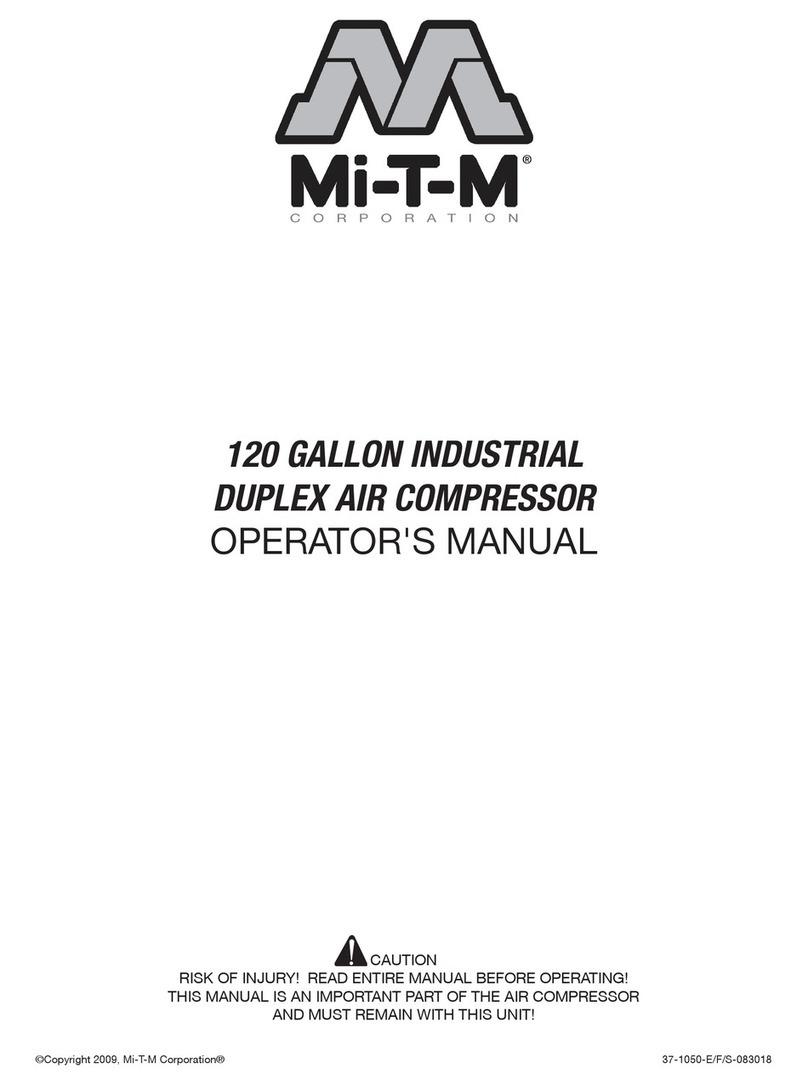
Mi-T-M
Mi-T-M ACD Series Operator's manual

HERKULES
HERKULES PRO-LINE PAC85L Translation of original instruction manual

Stanley
Stanley B 350/10/50 Instruction manual for owner's use
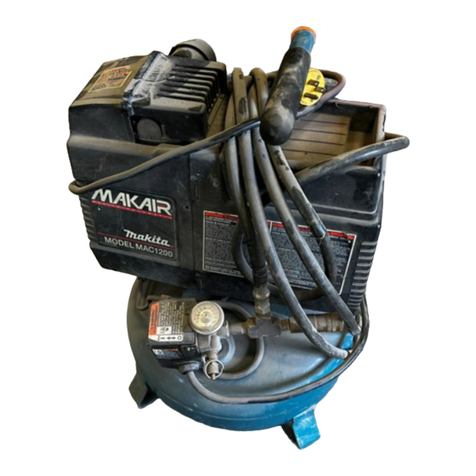
Makita
Makita MAC1200 owner's manual

Husky
Husky C303H Use and care guide
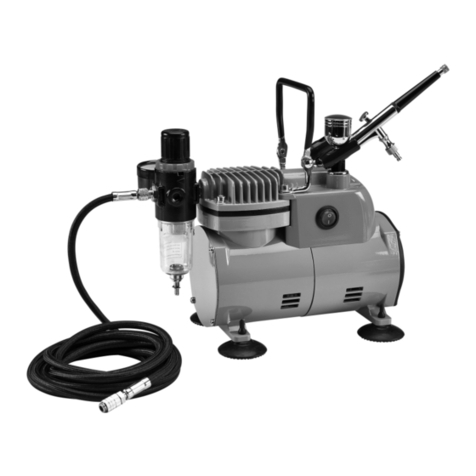
Avanti
Avanti 57637 Owner's manual & safety instructions

Gardner Denver
Gardner Denver ELECTRA-SAVER Operating and service manual
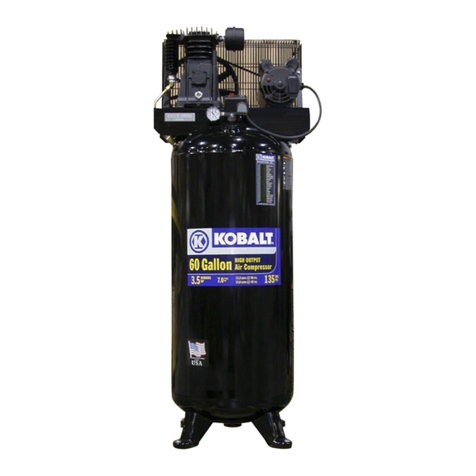
Kobalt
Kobalt K7060HFV user manual
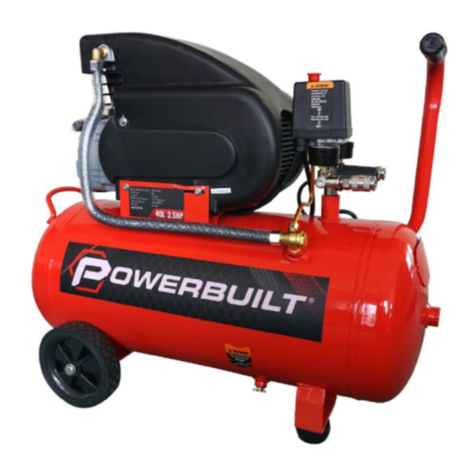
Powerbuilt
Powerbuilt AC4025 Owner's Manual and Operating Instructions
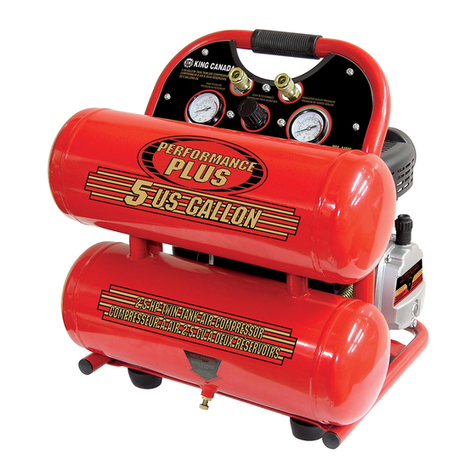
King Canada
King Canada 8488 Service manual
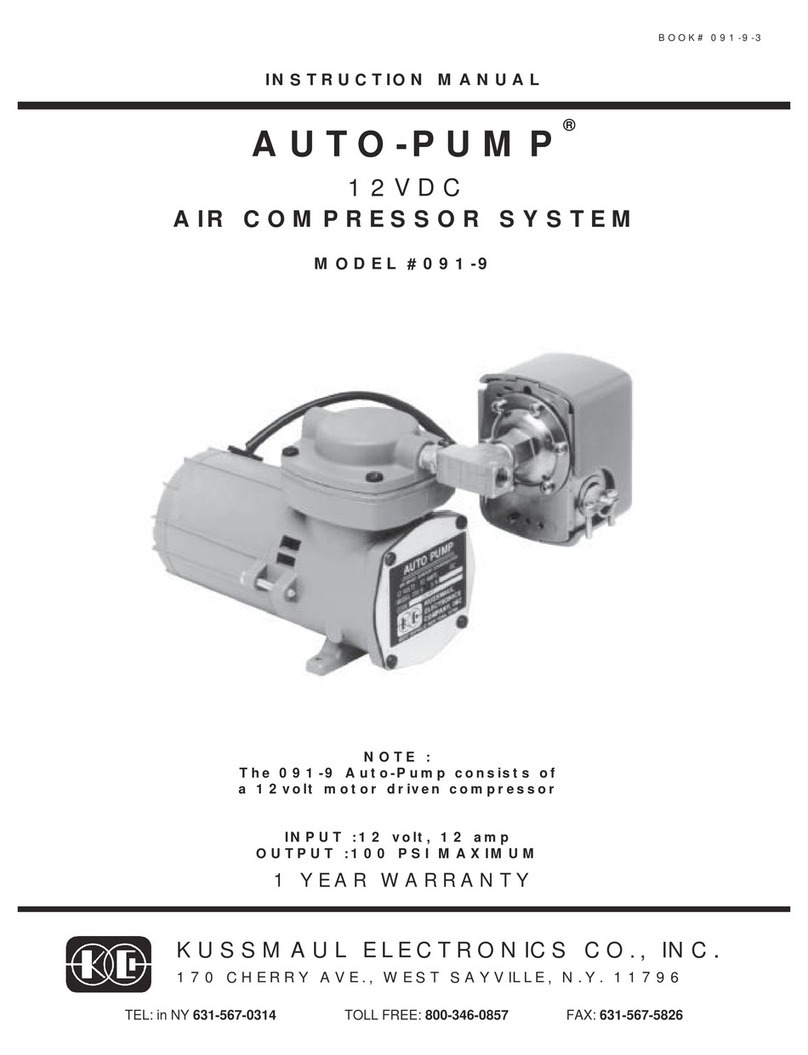
KUSSMAUL
KUSSMAUL 091-9 AUTO-PUMP instruction manual
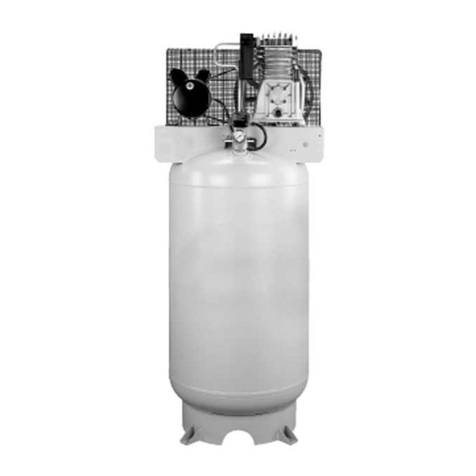
Porter-Cable
Porter-Cable CPLKC7080V2 instruction manual
